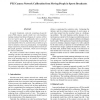Free Online Productivity Tools
i2Speak
i2Symbol
i2OCR
iTex2Img
iWeb2Print
iWeb2Shot
i2Type
iPdf2Split
iPdf2Merge
i2Bopomofo
i2Arabic
i2Style
i2Image
i2PDF
iLatex2Rtf
Sci2ools
133
click to vote
WACV
2012
IEEE
2012
IEEE
PTZ camera network calibration from moving people in sports broadcasts
In sports broadcasts, networks consisting of pan-tiltzoom (PTZ) cameras usually exhibit very wide baselines, making standard matching techniques for camera calibration very hard to apply. If, additionally, there is a lack of texture, finding corresponding image regions becomes almost impossible. However, such networks are often set up to observe dynamic scenes on a ground plane. Corresponding image trajectories produced by moving objects need to fulfill specific geometric constraints, which can be leveraged for camera calibration. We present a method which combines image trajectory matching with the self-calibration of rotating and zooming cameras, effectively reducing the remaining degrees of freedom in the matching stage to a 2D similarity transformation. Additionally, lines on the ground plane are used to improve the calibration. In the end, all extrinsic and intrinsic camera parameters are refined in a final bundle adjustment. The proposed algorithm was evaluated both qualita...
| Added | 25 Apr 2012 |
| Updated | 25 Apr 2012 |
| Type | Journal |
| Year | 2012 |
| Where | WACV |
| Authors | Jens Puwein, Remo Ziegler, Luca Ballan, Marc Pollefeys |
Comments (0)

